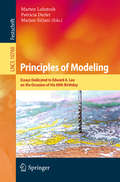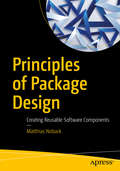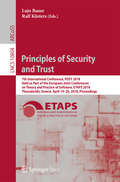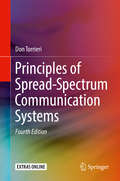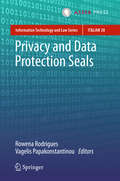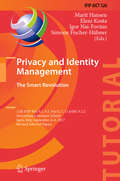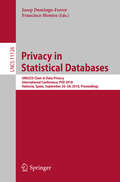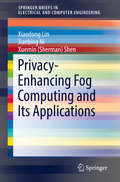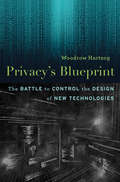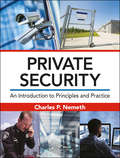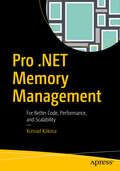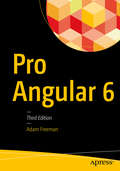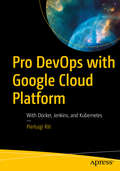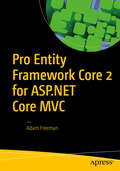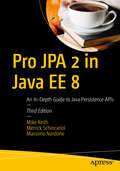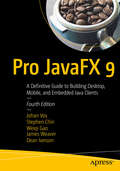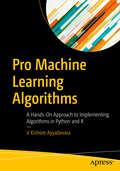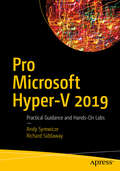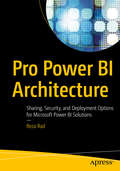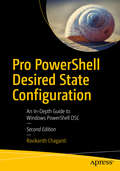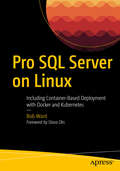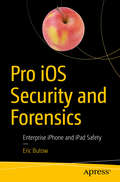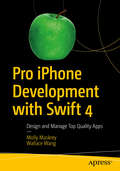- Table View
- List View
Principles of Modeling: Essays Dedicated to Edward A. Lee on the Occasion of His 60th Birthday (Lecture Notes in Computer Science #10760)
by Marjan Sirjani Marten Lohstroh Patricia DerlerThis Festschrift is published in honor of Edward A. Lee, Robert S. Pepper Distinguished Professor Emeritus and Professor in the Graduate School in the Department of Electrical Engineering and Computer Sciences at the University of California, Berkeley, USA, on the occasion of his 60th birthday.The title of this Festschrift is “Principles of Modeling" because Edward A. Lee has long been devoted to research that centers on the role of models in science and engineering. He has been examining the use and limitations of models, their formal properties, their role in cognition and interplay with creativity, and their ability to represent reality and physics. The Festschrift contains 29 papers that feature the broad range of Edward A. Lee’s research topics; such as embedded systems; real-time computing; computer architecture; modeling and simulation, and systems design.
Principles of Package Design: Creating Reusable Software Components
by Matthias NobackApply design principles to your classes, preparing them for reuse. You will use package design principles to create packages that are just right in terms of cohesion and coupling, and are user- and maintainer-friendly at the same time.The first part of this book walks you through the five SOLID principles that will help you improve the design of your classes. The second part introduces you to the best practices of package design, and covers both package cohesion principles and package coupling principles. Cohesion principles show you which classes should be put together in a package, when to split packages, and if a combination of classes may be considered a "package" in the first place. Package coupling principles help you choose the right dependencies and prevent wrong directions in the dependency graph of your packages.What You'll LearnApply the SOLID principles of class designDetermine if classes belong in the same packageKnow whether it is safe for packages to depend on each otherWho This Book Is ForSoftware developers with a broad range of experience in the field, who are looking for ways to reuse,share, and distribute their code
Principles of Security and Trust: 7th International Conference, Post 2018, Held As Part Of The European Joint Conferences On Theory And Practice Of Software, Etaps 2018, Thessaloniki, Greece, April 14-20, 2018, Proceedings (Lecture Notes in Computer Science #10804)
by Lujo Bauer Ralf KüstersThis open access book constitutes the proceedings of the 7th International Conference on Principles of Security and Trust, POST 2018, which took place in Thessaloniki, Greece, in April 2018, held as part of the European Joint Conference on Theory and Practice of Software, ETAPS 2018. The 13 papers presented in this volume were carefully reviewed and selected from 45 submissions. The papers are organized in topical sections named: information flow and non-intereference; leakage, information flow, and protocols; smart contracts and privacy; firewalls and attack-defense trees.
Principles of Spread-Spectrum Communication Systems
by Don TorrieriThis thoroughly revised textbook provides the fundamentals of spread-spectrum systems with a continued emphasis on theoretical principles. The revision includes new sections and appendices on characteristic functions and LaPlace transforms, orthonormal expansions of functions, the SNR wall in detection, multiple-input multiple-output systems, multicode and multirate systems, interference cancelers, complementary codes, chaos and ultrawideband systems, and the normalized LMS algorithm. As with previous editions, the author presents topics in a practical way that is of interest to both researchers and system designers. He includes updated problems at the end of each chapter, which are intended to assist readers in consolidating their knowledge and to provide practice in analytical techniques. In addition to the new and revised material, the author adds 50 new pages to make the book more accessible to graduate students in electrical engineering.
Privacy and Data Protection Seals (Information Technology and Law Series #28)
by Vagelis Papakonstantinou Rowena RodriguesThe book presents timely and needed contributions on privacy and data protection seals as seen from general, legal, policy, economic, technological, and societal perspectives. It covers data protection certification in the EU (i.e., the possibilities, actors and building blocks); the Schleswig-Holstein Data Protection Seal; the French Privacy Seal Scheme; privacy seals in the USA, Europe, Japan, Canada, India and Australia; controversies, challenges and lessons for privacy seals; the potential for privacy seals in emerging technologies; and an economic analysis. This book is particularly relevant in the EU context, given the General Data Protection Regulation (GDPR) impetus to data protection certification mechanisms and the dedication of specific provisions to certification. Its coverage of practices in jurisdictions outside the EU also makes it relevant globally. This book will appeal to European legislators and policy-makers, privacy and data protection practitioners, certification bodies, international organisations, and academics.Rowena Rodrigues is a Senior Research Analyst with Trilateral Research Ltd. in London and Vagelis Papakonstantinou is a Senior Researcher at the Vrije Universiteit Brussel in Brussels.
Privacy and Identity Management. The Smart Revolution: 12th IFIP WG 9.2, 9.5, 9.6/11.7, 11.6/SIG 9.2.2 International Summer School, Ispra, Italy, September 4-8, 2017, Revised Selected Papers (IFIP Advances in Information and Communication Technology #526)
by Eleni Kosta Simone Fischer-Hübner Marit Hansen Igor Nai-FovinoThis book contains selected papers presented at the 12th IFIP WG 9.2, 9.5, 9.6/11.7, 11.6/SIG 9.2.2 International Summer School on Privacy and Identity Management, held in Ispra, Italy, in September 2017.The 12 revised full papers, 5 invited papers and 4 workshop papers included in this volume were carefully selected from a total of 48 submissions and were subject to a three-phase review process. The papers combine interdisciplinary approaches to bring together a host of perspectives: technical, legal, regulatory, socio-economic, social, societal, political, ethical, anthropological, philosophical, and psychological. They are organized in the following topical sections: privacy engineering; privacy in the era of the smart revolution; improving privacy and security in the era of smart environments; safeguarding personal data and mitigating risks; assistive robots; and mobility and privacy.
Privacy as Trust: Information Privacy for an Information Age
by Ari Ezra WaldmanIt seems like there is no such thing as privacy anymore. But the truth is that privacy is in danger only because we think about it in narrow, limited, and outdated ways. In this transformative work, Ari Ezra Waldman, leveraging the notion that we share information with others in contexts of trust, offers a roadmap for data privacy that will better protect our information in a digitized world. With case studies involving websites, online harassment, intellectual property, and social robots, Waldman shows how 'privacy as trust' can be applied in the most challenging real-world contexts to make privacy work for all of us. This book should be read by anyone concerned with reshaping the theory and practice of privacy in the modern world.
Privacy in Statistical Databases: UNESCO Chair in Data Privacy, International Conference, PSD 2018, Valencia, Spain, September 26–28, 2018, Proceedings (Lecture Notes in Computer Science #11126)
by Josep Domingo-Ferrer Francisco MontesThis book constitutes the refereed proceedings of the International Conference on Privacy in Statistical Databases, PSD 2018, held in Valencia, Spain, in September 2018 under the sponsorship of the UNESCO Chair in Data Privacy. The 23 revised full papers presented were carefully reviewed and selected from 42 submissions. The papers are organized into the following topics: tabular data protection; synthetic data; microdata and big data masking; record linkage; and spatial and mobility data.Chapter "SwapMob: Swapping Trajectories for Mobility Anonymization" is available open access under a Creative Commons Attribution 4.0 International License via link.springer.com.
Privacy-Enhancing Fog Computing and Its Applications (SpringerBriefs in Electrical and Computer Engineering)
by Xiaodong Lin Xuemin Sherman Shen Jianbing NiThis SpringerBrief covers the security and privacy challenges in fog computing, and proposes a new secure and privacy-preserving mechanisms to resolve these challenges for securing fog-assisted IoT applications. Chapter 1 introduces the architecture of fog-assisted IoT applications and the security and privacy challenges in fog computing. Chapter 2 reviews several promising privacy-enhancing techniques and illustrates examples on how to leverage these techniques to enhance the privacy of users in fog computing. Specifically, the authors divide the existing privacy-enhancing techniques into three categories: identity-hidden techniques, location privacy protection and data privacy enhancing techniques. The research is of great importance since security and privacy problems faced by fog computing impede the healthy development of its enabled IoT applications. With the advanced privacy-enhancing techniques, the authors propose three secure and privacy-preserving protocols for fog computing applications, including smart parking navigation, mobile crowdsensing and smart grid. Chapter 3 introduces identity privacy leakage in smart parking navigation systems, and proposes a privacy-preserving smart parking navigation system to prevent identity privacy exposure and support efficient parking guidance retrieval through road-side units (fogs) with high retrieving probability and security guarantees. Chapter 4 presents the location privacy leakage, during task allocation in mobile crowdsensing, and propose a strong privacy-preserving task allocation scheme that enables location-based task allocation and reputation-based report selection without exposing knowledge about the location and reputation for participators in mobile crowdsensing. Chapter 5 introduces the data privacy leakage in smart grid, and proposes an efficient and privacy-preserving smart metering protocol to allow collectors (fogs) to achieve real-time measurement collection with privacy-enhanced data aggregation. Finally, conclusions and future research directions are given in Chapter 6. This brief validates the significant feature extension and efficiency improvement of IoT devices without sacrificing the security and privacy of users against dishonest fog nodes. It also provides valuable insights on the security and privacy protection for fog-enabled IoT applications. Researchers and professionals who carry out research on security and privacy in wireless communication will want to purchase this SpringerBrief. Also, advanced level students, whose main research area is mobile network security will also be interested in this SpringerBrief.
Privacy’s Blueprint: The Battle to Control the Design of New Technologies
by Woodrow HartzogEvery day, Internet users interact with technologies designed to undermine their privacy. Social media apps, surveillance technologies, and the Internet of Things are all built in ways that make it hard to guard personal information. And the law says this is okay because it is up to users to protect themselves—even when the odds are deliberately stacked against them. In Privacy’s Blueprint, Woodrow Hartzog pushes back against this state of affairs, arguing that the law should require software and hardware makers to respect privacy in the design of their products. Current legal doctrine treats technology as though it were value-neutral: only the user decides whether it functions for good or ill. But this is not so. As Hartzog explains, popular digital tools are designed to expose people and manipulate users into disclosing personal information. Against the often self-serving optimism of Silicon Valley and the inertia of tech evangelism, Hartzog contends that privacy gains will come from better rules for products, not users. The current model of regulating use fosters exploitation. Privacy’s Blueprint aims to correct this by developing the theoretical underpinnings of a new kind of privacy law responsive to the way people actually perceive and use digital technologies. The law can demand encryption. It can prohibit malicious interfaces that deceive users and leave them vulnerable. It can require safeguards against abuses of biometric surveillance. It can, in short, make the technology itself worthy of our trust.
Private Security and the Law (5th Edition)
by Charles P. Nemeth<p>Private Security and the Law, Fifth Edition, is a singular resource that provides the most comprehensive analysis of practices in the security industry with respect to law, regulation, licensure, and constitutional questions of case and statutory authority. <p>The book begins with a historical background of the security industry, laws and regulations that walks step-by-step through the analysis of the development of case law over the years as it applies to situations commonly faced by security practitioners. It describes the legal requirements faced by security firms and emphasizes the liability problems common to security operations, including negligence and tortious liability, civil actions frequently litigated, and strategies to avoid legal actions that affect business efficiency. <p>In addition, chapters examine the constitutional and due-process dimensions of private security both domestically and internationally, including recent cases and trends that are likely to intensify in the future. Updated coverage new to this edition includes developments in statutory authority, changes to state and federal processes of oversight and licensure, and special analysis of public-private cooperative relationships in law enforcement.</p>
Private Security: An Introduction to Principles and Practice
by Charles P. NemethThere are few textbooks available that outline the foundation of security principles while reflecting the modern practices of private security as an industry. Private Security: An Introduction to Principles and Practice takes a new approach to the subject of private sector security that will be welcome addition to the field. The book focuses on the recent history of the industry and the growing dynamic between private sector security and public safety and law enforcement. Coverage will include history and security theory, but emphasis is on current practice, reflecting the technology-driven, fast-paced, global security environment. Such topics covered include a history of the security industry, security law, risk management, physical security, Human Resources and personnel, investigations, institutional and industry-specific security, crisis and emergency planning, critical infrastructure protection, IT and computer security, and more. Rather than being reduced to single chapter coverage, homeland security and terrorism concepts are referenced throughout the book, as appropriate. Currently, it vital that private security entities work with public sector authorities seamlessly—at the state and federal levels—to share information and understand emerging risks and threats. This modern era of security requires an ongoing, holistic focus on the impact and implications of global terror incidents; as such, the book’s coverage of topics consciously takes this approach throughout. Highlights include: Details the myriad changes in security principles, and the practice of private security, particularly since 9/11 Focuses on both foundational theory but also examines current best practices—providing sample forms, documents, job descriptions, and functions—that security professionals must understand to perform and succeed Outlines the distinct, but growing, roles of private sector security companies versus the expansion of federal and state law enforcement security responsibilities Includes key terms, learning objectives, end of chapter questions, Web exercises, and numerous references—throughout the book—to enhance student learning Presents the full range of career options available for those looking entering the field of private security Includes nearly 400 full-color figures, illustrations, and photographs. Private Security: An Introduction to Principles and Practice provides the most comprehensive, up-to-date coverage of modern security issues and practices on the market. Professors will appreciate the new, fresh approach, while students get the most "bang for their buck," insofar as the real-world knowledge and tools needed to tackle their career in the ever-growing field of private industry security. An instructor’s manual with Exam questions, lesson plans, and chapter PowerPoint® slides are available upon qualified course adoption.
Pro .NET Memory Management: For Better Code, Performance, and Scalability
by Konrad KokosaUnderstand .NET memory management internal workings, pitfalls, and techniques in order to effectively avoid a wide range of performance and scalability problems in your software. Despite automatic memory management in .NET, there are many advantages to be found in understanding how .NET memory works and how you can best write software that interacts with it efficiently and effectively. Pro .NET Memory Management is your comprehensive guide to writing better software by understanding and working with memory management in .NET.Thoroughly vetted by the .NET Team at Microsoft, this book contains 25 valuable troubleshooting scenarios designed to help diagnose challenging memory problems. Readers will also benefit from a multitude of .NET memory management “rules” to live by that introduce methods for writing memory-aware code and the means for avoiding common, destructive pitfalls.What You'll LearnUnderstand the theoretical underpinnings of automatic memory managementTake a deep dive into every aspect of .NET memory management, including detailed coverage of garbage collection (GC) implementation, that would otherwise take years of experience to acquireGet practical advice on how this knowledge can be applied in real-world software developmentUse practical knowledge of tools related to .NET memory management to diagnose various memory-related issuesExplore various aspects of advanced memory management, including use of Span and Memory typesWho This Book Is For.NET developers, solution architects, and performance engineers
Pro Angular 6
by Adam FreemanGet the most from Angular 6, the leading framework for building dynamic JavaScript applications. Understand the MVC pattern and the benefits it can offer.Best-selling author Adam Freeman shows you how to use Angular in your projects, starting from the nuts and bolts and building up to the most advanced and sophisticated features, going in-depth to give you the knowledge you need. Chapters include common problems and how to avoid them.What You’ll LearnGain a solid architectural understanding of the MVC PatternCreate rich and dynamic web app clients using Angular 6Use the ng tools to create and build an Angular projectExtend and customize Angular 6Test your Angular 6 projectsWhat's New in This EditionRevised for the features and changes in Angular 6Covers @angular/cli, ng command line tools, and WebPackIncludes HttpClient for simplified asynchronous HTTP requestsPresents updates to pipes and localized text displayWho This Book Is ForWeb developers with a foundation knowledge of HTML and JavaScript who want to create rich client-side applications
Pro DevOps with Google Cloud Platform: With Docker, Jenkins, And Kubernetes
by Pierluigi RitiUse DevOps principles with Google Cloud Platform (GCP) to develop applications and services. This book builds chapter by chapter to a complete real-life scenario, explaining how to build, monitor, and maintain a complete application using DevOps in practice.Starting with core DevOps concepts, continuous integration, and continuous delivery, you’ll cover common tools including Jenkins, Docker, and Kubernetes in the context of a real microservices application to deploy in the cloud. You will also create a monitor for your cloud and see how to use its data to prevent errors and improve the stability of the system. By the end of Pro DevOps with Google Cloud Platform, you will be able to deploy, maintain, and monitor a real application with GCP.What You Will LearnBuild and deploy applications and services using DevOps on Google Cloud Platform Maintain a complete continuous integration (CI) and continuous delivery (CD) pipelineUse containerization with Docker and KubernetesCarry out CD with GCP and JenkinsCreate microservices with Jenkins, Docker, and KubernetesMonitor your newly deployed application and its deployment and performanceSet up security and manage your network with GCP Who This Book Is ForDevelopers and software architects who want to implement DevOps in practice. Some prior programming experience is recommended as well as a basic knowledge of a Linux command-line environment.
Pro Entity Framework Core 2 for ASP.NET Core MVC
by Adam FreemanModel, map, and access data effectively with Entity Framework Core 2, the latest evolution of Microsoft’s object-relational mapping framework. You will access data utilizing .NET objects via the most common data access layer used in ASP.NET Core MVC 2 projects. Best-selling author Adam Freeman explains how to get the most from Entity Framework Core 2 in MVC projects. He begins by describing the different ways that Entity Framework Core 2 can model data and the different types of databases that can be used. He then shows you how to use Entity Framework Core 2 in your own MVC projects, starting from the nuts and bolts and building up to the most advanced and sophisticated features, going in-depth to give you the knowledge you need. Chapters include common problems and how to avoid them.What You’ll LearnGain a solid architectural understanding of Entity Framework Core 2Create databases using your MVC data model Create MVC models using an existing database Access data in an MVC application using Entity Framework Core 2Use Entity Framework in RESTful Web ServicesWho This Book Is ForASP.NET Core MVC 2 developers who want to use Entity Framework Core 2 as the data access layer in their projects
Pro JPA 2 in Java EE 8: An In-depth Guide To Java Persistence Apis
by Mike Keith Merrick Schincariol Massimo NardoneLearn to use the Java Persistence API (JPA) and other related APIs as found in the Java EE 8 platform from the perspective of one of the specification creators. A one-of-a-kind resource, this in-depth book provides both theoretical and practical coverage of JPA usage for experienced Java developers. Authors Mike Keith, Merrick Schincariol and Massimo Nardone take a hands-on approach, based on their wealth of experience and expertise, by giving examples to illustrate each concept of the API and showing how it is used in practice. The examples use a common model from an overarching sample application, giving you a context from which to start and helping you to understand the examples within an already familiar domain. After completing Pro JPA 2 in Java EE 8, you will have a full understanding of JPA and be able to successfully code applications using its annotations and APIs. The book also serves as an excellent reference guide. What You Will Learn Use the JPA in the context of enterprise applications Work with object relational mappings (ORMs), collection mappings and more Build complex enterprise Java applications that persist data long after the process terminates Connect to and persist data with a variety of databases, file formats, and more Use queries, including the Java Persistence Query Language (JPQL) Carry out advanced ORM, queries and XML mappings Package, deploy and test your Java persistence-enabled enterprise applications Who This Book Is For Experienced Java programmers and developers with at least some prior experience with J2EE or Java EE platform APIs.
Pro JavaFX 9
by Johan Vos Weiqi Gao Stephen Chin Dean Iverson James WeaverUse the JavaFX platform to create rich-client Java applications and discover how you can use this powerful Java-based UI platform, which is capable of handling large-scale data-driven business applications for PC as well as mobile and embedded devices. The expert authors cover the new more modular JavaFX 9 APIs, development tools, and best practices and provide code examples that explore the exciting new features provided with JavaFX 9, part of Oracle's new Java 9 release. Pro JavaFX 9: A Definitive Guide to Building Desktop, Mobile, and Embedded Java Clients also contains engaging tutorials that cover virtually every facet of JavaFX development and reference materials on JavaFX that augment the JavaFX API documentation. New material in this edition includes JavaFX UI controls and CSS APIs for modularization. Additionally, there is coverage of the Shader DSL for JavaFX that allows you to generate Shaders for OpenGL and Direct3D. After reading and using this book, you'll have the knowledge to give you an edge in your next JavaFX-based project. What You'll Learn Create a user interface in JavaFX Use SceneBuilder to create a user interface Build dynamic UI layouts in JavaFX and using the JavaFX UI controls Create charts in JavaFX Design and deploy for embedded, mobile and tablet Leverage JavaFX languages and markup Who This Book Is For Experienced Java programmers looking to learn and leverage JavaFX 9 for rich client-side Java development.
Pro Machine Learning Algorithms: A Hands-On Approach to Implementing Algorithms in Python and R
by V Kishore AyyadevaraBridge the gap between a high-level understanding of how an algorithm works and knowing the nuts and bolts to tune your models better. This book will give you the confidence and skills when developing all the major machine learning models. In Pro Machine Learning Algorithms, you will first develop the algorithm in Excel so that you get a practical understanding of all the levers that can be tuned in a model, before implementing the models in Python/R.You will cover all the major algorithms: supervised and unsupervised learning, which include linear/logistic regression; k-means clustering; PCA; recommender system; decision tree; random forest; GBM; and neural networks. You will also be exposed to the latest in deep learning through CNNs, RNNs, and word2vec for text mining. You will be learning not only the algorithms, but also the concepts of feature engineering to maximize the performance of a model. You will see the theory along with case studies, such as sentiment classification, fraud detection, recommender systems, and image recognition, so that you get the best of both theory and practice for the vast majority of the machine learning algorithms used in industry. Along with learning the algorithms, you will also be exposed to running machine-learning models on all the major cloud service providers.You are expected to have minimal knowledge of statistics/software programming and by the end of this book you should be able to work on a machine learning project with confidence. What You Will LearnGet an in-depth understanding of all the major machine learning and deep learning algorithms Fully appreciate the pitfalls to avoid while building modelsImplement machine learning algorithms in the cloud Follow a hands-on approach through case studies for each algorithmGain the tricks of ensemble learning to build more accurate modelsDiscover the basics of programming in R/Python and the Keras framework for deep learningWho This Book Is ForBusiness analysts/ IT professionals who want to transition into data science roles. Data scientists who want to solidify their knowledge in machine learning.
Pro Microsoft Hyper-V 2019: Practical Guidance And Hands-on Labs
by Andy Syrewicze Richard SiddawaySuccessfully create and manage your Hyper-V environment without any of the marketing fluff. This book's lab-driven, hands-on approach will get you up and running as quickly and efficiently as possible.Virtualization is the cornerstone of today’s data center. As a modern-day IT pro, you are required to manage environments that are in a regular state of flux and increasing in both size and complexity. To keep up, you need practical information in a format that is succinct, yet comprehensive and highly applicable.Pro Hyper-V 2019 breaks down critical and time-saving topics into a series of easy-to-digest chapters, showing you how to perform Hyper-V management tasks using both GUI and PowerShell-based tools. Building on your existing knowledge of Windows Server management, Active Directory, networking, and storage, experts and Microsoft MVPs Syrewicze and Siddaway begin with a foundation of why computing workloads are virtualized. This is followed by chapters covering the range of management tasks associated with virtualized environments, including: managing hosts and guest machines; networking, storage, and high availability (host and guest); disaster recovery and virtual machine migration; and monitoring. What You'll LearnApply practical information to administer your Hyper-V environmentsUnderstand multiple administration styles (GUI, command line, and automation)Written by IT pros for IT pros – just the information you really need without the paddingAdminister and use containersUtilize hands-on labs to learn about storage, networking, and high availability Who This Book Is For IT administrators tasked with implementing Hyper-V environments or migrating from VMware. IT pros joining a team that is responsible for managing Hyper-V and “lone administrators” covering the gamut in smaller organizations will also find this book indispensable.
Pro Power BI Architecture: Sharing, Security, and Deployment Options for Microsoft Power BI Solutions
by Reza RadArchitect and deploy a Power BI solution. This book will help you understand the many available options and choose the best combination for hosting, developing, sharing, and deploying a Power BI solution within your organization.Pro Power BI Architecture provides detailed examples and explains the different methods available for sharing and securing Power BI content so that only intended recipients can see it. Commonly encountered problems you will learn to handle include content unexpectedly changing while users are in the process of creating reports and building analysis, methods of sharing analyses that don’t cover all the requirements of your business or organization, and inconsistent security models.The knowledge provided in this book will allow you to choose an architecture and deployment model that suits the needs of your organization, ensuring that you do not spend your time maintaining your solution but on using it for its intended purpose and gaining business value from mining and analyzing your organization’s data. What You'll LearnArchitect and administer enterprise-level Power BI solutionsChoose the right sharing method for your Power BI solutionCreate and manage environments for development, testing, and productionImplement row level security in multiple ways to secure your dataSave money by choosing the right licensing planSelect a suitable connection type—Live Connection, DirectQuery, or Scheduled Refresh—for your use caseSet up a Power BI gateway to bridge between on-premises data sources and the Power BI cloud serviceWho This Book Is ForData analysts, developers, architects, and managers who want to leverage Power BI for their reporting solution
Pro PowerShell Desired State Configuration: Using Windows Powershell Dsc And Dsc Core
by Ravikanth ChagantiUse Windows PowerShell Desired State Configuration (DSC) to configure your infrastructure on-premises and in the cloud. In an environment where changes and deployments are happening all the time, DSC makes the necessary adjustments to the system so you don’t have to. Pro PowerShell Desired State Configuration shows you how.PowerShell Desired State Configuration (DSC) is a powerful configuration management platform that makes it easier than ever to perform configuration management of your infrastructure, whether on-premises or in the cloud. With Pro PowerShell Desired State Configuration, Ravikanth Chaganti revises and significantly expands his previous edition, bringing you a complete in-depth reference for applying this evolving technology in your day-to-day work.What’s new in this edition?Get up-to-date, in-depth guidance on DSC in the data centerUnderstand the central role that DSC plays in DevOps todayIntegrate DSC into build and release management toolsLearn to think and act like a developer when automating your configuration management, creating a testable, robust process that you can use again and againFind out why and how DSC has an important role to play in public and private cloud deploymentsApply DSC in the cloud with Microsoft Azure or Amazon Web Services or Google Cloud PlatformWho This Book Is ForIT administrators, developers and DevOps engineers working in Windows-based data center environments. With a little prior PowerShell scripting experience, this book can be used as an in-depth reference to creating, customizing, and extending DSC in Windows. IT administrators with limited scripting experience will also find this book a useful overview of what DSC offers and how to use DSC resources to automate configuration management and deployment.
Pro SQL Server on Linux: Including Container-Based Deployment with Docker and Kubernetes
by Bob WardGet SQL Server up and running on the Linux operating system and containers. No database professional managing or developing SQL Server on Linux will want to be without this deep and authoritative guide by one of the most respected experts on SQL Server in the industry. Get an inside look at how SQL Server for Linux works through the eyes of an engineer on the team that made it possible.Microsoft SQL Server is one of the leading database platforms in the industry, and SQL Server 2017 offers developers and administrators the ability to run a database management system on Linux, offering proven support for enterprise-level features and without onerous licensing terms. Organizations invested in Microsoft and open source technologies are now able to run a unified database platform across all their operating system investments. Organizations are further able to take full advantage of containerization through popular platforms such as Docker and Kubernetes. Pro SQL Server on Linux walks you through installing and configuring SQL Server on the Linux platform. The author is one of the principal architects of SQL Server for Linux, and brings a corresponding depth of knowledge that no database professional or developer on Linux will want to be without. Throughout this book are internals of how SQL Server on Linux works including an in depth look at the innovative architecture.The book covers day-to-day management and troubleshooting, including diagnostics and monitoring, the use of containers to manage deployments, and the use of self-tuning and the in-memory capabilities. Also covered are performance capabilities, high availability, and disaster recovery along with security and encryption. The book covers the product-specific knowledge to bring SQL Server and its powerful features to life on the Linux platform, including coverage of containerization through Docker and Kubernetes.What You'll LearnLearn about the history and internal of the unique SQL Server on Linux architecture.Install and configure Microsoft’s flagship database product on the Linux platformManage your deployments using container technology through Docker and KubernetesKnow the basics of building databases, the T-SQL language, and developing applications against SQL Server on LinuxUse tools and features to diagnose, manage, and monitor SQL Server on LinuxScale your application by learning the performance capabilities of SQL ServerDeliver high availability and disaster recovery to ensure business continuitySecure your database from attack, and protect sensitive data through encryptionTake advantage of powerful features such as Failover Clusters, Availability Groups, In-Memory Support, and SQL Server’s Self-Tuning EngineLearn how to migrate your database from older releases of SQL Server and other database platforms such as Oracle and PostgreSQLBuild and maintain schemas, and perform management tasks from both GUI and command lineWho This Book Is ForDevelopers and IT professionals who are new to SQL Server and wish to configure it on the Linux operating system. This book is also useful to those familiar with SQL Server on Windows who want to learn the unique aspects of managing SQL Server on the Linux platform and Docker containers. Readers should have a grasp of relational database concepts and be comfortable with the SQL language.
Pro iOS Security and Forensics: Enterprise Iphone And Ipad Safety
by Eric ButowExamine how to keep iOS devices safe in the physical world, including creating company policies for iPhones; assessing and defending against cyber vulnerabilities and attacks; working with preinstalled as well as third party tools; and strategies for keeping your data safe including backing up and screen locks.Managing and maintaining iPhones and iPads in a corporate or other business environment inherently requires strict attention to security concerns. Managers and IT professionals need to know how to create and communicate business policies for using iOS devices in the workplace, and implement security and forensics tools to manage and protect them.The iPhone and iPad are both widely used across businesses from Fortune 500 companies down to garage start-ups. All of these devices must have secure and monitorable ways to connect to the internet, store and transmit data without leaks, and even be managed in the event of a physical theft. Pro iOS Security and Forensics covers all these concerns as well as also offering tips for communicating with employees about the policies your business puts in place, why those policies are important, and how to follow them.What You'll LearnReview communicating policies and requirements for use of iPhones Keep your iPhone safe in the physical world Connect to the Internet securely Explore strategies for keeping your data safe including backing up and screen locksWho This Book Is ForManagers and IT professionals working in a business environment with iPhones and iPads.
Pro iPhone Development with Swift 4: Design and Manage Top Quality Apps
by Wallace Wang Molly MaskreyAcquire and master the information required to take you to the next level beyond basic iPhone development using Swift. In this follow up work to the best selling Beginning iPhone Development with Swift, you’ll learn how to improve your apps by managing the performance of your programs using parallelization, getting data in and out of the cloud, using gestures, the camera, 3D touch, sensors as well as newer features having debuted this year.In its fourth edition, Pro iPhone Development with Swift 4 covers the additional information you want to know to extend your apps into the next level.What You Will LearnAdd parallel functionality using Grand Central DispatchUse the camera and access photosUse SiriKitWho This Book is ForAspiring iOS app developers familiar with the Apple Swift programming language and/or the iOS SDK, but ready to move to the next level.
